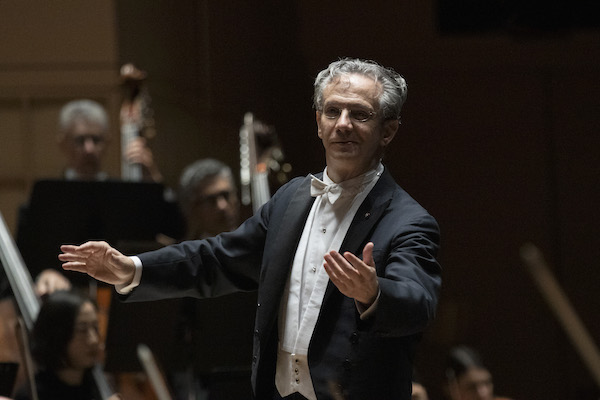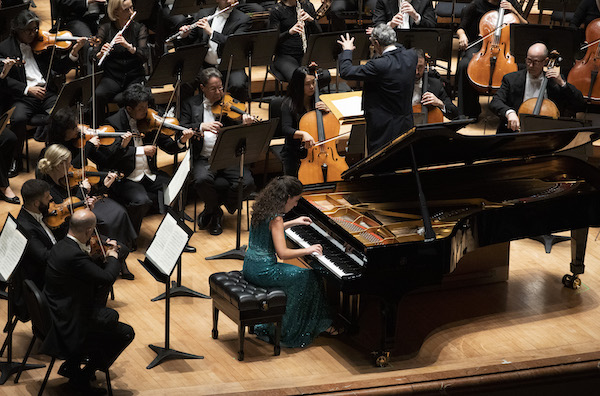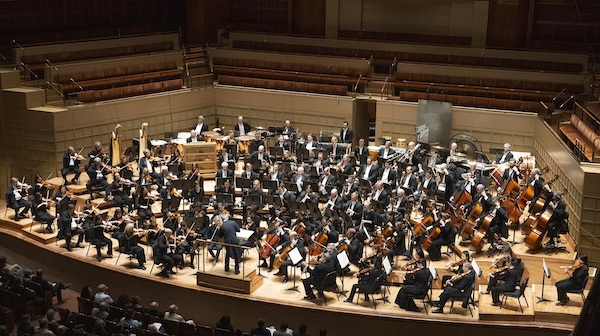Luisi sets a new, uncharted course with Dallas Symphony

Fabio Luisi, the Dallas Symphony Orchestra’s music director designate, is conducting five programs this season–the last before the label “designate” is removed from his title and he takes over the orchestra in earnest.
The first of these opened Thursday night and demonstrated– both in programming and performance–how starkly Luisi differs from his predecessor Jaap van Zweden, who now helms the New York Philharmonic.
Van Zweden programmed few works by living composers, and fewer still by women and composers of color. Luisi, at least at the outset, is very deliberately doing the opposite.
After opening remarks, a performance of the National Anthem, and a tribute to major DSO donor Ross Perot, who died earlier this year, the concert began with Augusta Read Thomas’s Aureole.
Thomas wrote her 2013 piece explicitly to precede a performance of Beethoven’s Symphony No. 9, although it has clearly taken on a life outside that role. While the piece is written using conventional notation, she has also created a visual map for the work.
While this choice of a leadoff item is an important indicator of the direction the orchestra will be taking in the Luisi era, the performance itself was a mixed bag. The ample percussion section, led by newly hired principal George Nickson, have seldom sounded better, and principal trombone Barry Hearn floated a buttery, elegant solo.
Other sections did not fare as well. Playing without a regular principal, the trumpets sometimes floundered, especially in high writing, and the fanfare that opens Thomas’ piece. Aureoleitself, with near-melodic sections interspersed with less tonal interludes, is worthy of multiple listens. The composer was present Thursday and took a bow from the stage.

The program’s centerpiece was far more conventional: Beethoven’s Piano Concerto No. 5, the “Emperor,” with soloist Beatrice Rana. Having won the silver medal in the 2013 Van Cliburn International Piano Competition in Fort Worth, Rana is something of a local favorite. Also, like Luisi, she is Italian and he therefore an excellent choice for Luisi’s first program of the season.
Luisi elected to use a relatively large orchestra for his Beethoven, which mostly worked well. Although she showed herself capable of gorgeous, lilting lyricism, Rana tended to be heavy-handed in the more technical sections of the concerto, with overly pounding fortes, so the larger orchestra provided needed balance.
In the second half of the program, Luisi and the Dallas Symphony gave listeners a rare opportunity to hear Richard Strauss’s massive tone poem Eine Alpensinfonie (An Alpine Symphony).

The work depicts a mountain day hike, beginning and ending with night, and then taking listeners from sunrise to sunset. While the hike begins pleasantly enough, with musical depictions of a forest, a waterfall, and a meadow (complete with cows clanking their bells), the hike soon becomes more difficult, and the hikers briefly get lost, make their way across a glacier, traverse a precarious bit, and encounter fog, then a scary thunderstorm before they make their way safely down the mountain.
This piece shares familiar musical language with Strauss’s better-known tone poems such as Don Juanand Also Sprach Zarathustra. But it lacks the memorable melodies of those earlier works. It also requires a dauntingly large orchestra of over 100 personnel, including organ, two harps, and a large brass sections including Wagner tubas, and a heckelphone (a double reed instrument pitched in between an English horn and a bassoon).
Thursday’sDie Alpensinfonieat its best was often thrilling. Percussion was again exemplary, whether playing more conventional instruments or making a storm with a wind machine and a huge thunder sheet. Orchestral tuttis were magnificent. Principal oboe Erin Hannigan produced a thrilling extended solo on the mountain top, with a distinct sense that Luisi was giving her free rein.
The viola section has once again been moved to the outside of the stage, which resulted in a more balanced string sound overall. However, former principal horn David Cooper decamping to the Chicago Symphony has done the horn section no favors; woodwind intonation likewise sometimes lacked precision.
There were certainly some glorious moments Thursday, but as yet Luisi does not have this orchestra sounding its best. Luisi’s elegant podium technique and passionate commitment will, one hopes produce more consistently refined playing as this partnership finds its footing. The Dallas Symphony has been accustomed to a micromanager, and adapting to Luisi’s less controlling style will take some time.
The program will be repeated 7:30 p.m. Friday and Saturday and at 2:30 p.m. Sunday at Meyerson Symphony Center. mydso.com


